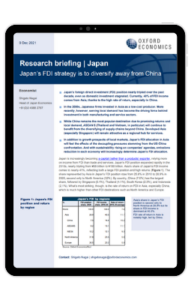Research Briefing
| Dec 10, 2021
Japan’s FDI strategy is to diversify away from China

Japan’s foreign direct investment (FDI) position nearly tripled over the past decade, even as domestic investment stagnated. Currently, 40% of FDI income comes from Asia, thanks to the high rate of return, especially in China.
What you will learn:
- In the 2000s, Japanese firms invested in Asia as a low-cost producer. More recently, however, serving local demand has become the driving force behind investment in both manufacturing and service sectors.
- While China remains the most popular destination due to promising returns and local demand, ASEAN 5 (Thailand and Vietnam, in particular) will continue to benefit from the diversifying of supply chains beyond China. Developed Asia (especially Singapore) will remain attractive as a regional hub for services.
- In addition to growth prospects of local markets, Japan’s FDI allocation in Asia will feel the effects of the decoupling pressures stemming from the US-China confrontation. And with sustainability rising on companies’ agendas, emissions reduction in each economy will increasingly determine Japan’s FDI allocation.
Tags:
Related Services

Post
US Key Themes 2026: Exceptionalism amid fragmentation
US exceptionalism is alive and well, and that won't change in 2026.
Find Out More
Post
Global Key themes 2026: Bullish on US despite AI bubble fears
We anticipate another year of broadly steady and unexceptional global GDP growth, but with some more interesting stories running below the surface.
Find Out More[autopilot_shortcode]
